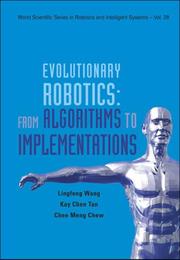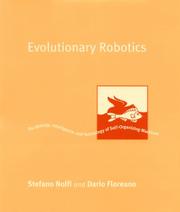| Listing 1 - 10 of 24 | << page >> |
Sort by
|
Book
Year: 2022 Publisher: New York, New York : Association for Computing Machinery,
Abstract | Keywords | Export | Availability | Bookmark
 Loading...
Loading...Choose an application
- Reference Manager
- EndNote
- RefWorks (Direct export to RefWorks)

ISBN: 128137329X 9786611373290 9812773142 9789812773142 9789812568700 9789812773142 9812568700 Year: 2006 Volume: v. 28 Publisher: New Jersey World Scientific Pub.
Abstract | Keywords | Export | Availability | Bookmark
 Loading...
Loading...Choose an application
- Reference Manager
- EndNote
- RefWorks (Direct export to RefWorks)
This invaluable book comprehensively describes evolutionary robotics and computational intelligence, and how different computational intelligence techniques are applied to robotic system design. It embraces the most widely used evolutionary approaches with their merits and drawbacks, presents some related experiments for robotic behavior evolution and the results achieved, and shows promising future research directions. Clarity of explanation is emphasized such that a modest knowledge of basic evolutionary computation, digital circuits and engineering design will suffice for a thorough unders
Evolutionary robotics. --- Robotics. --- Automation --- Machine theory --- Robotics
Book
Abstract | Keywords | Export | Availability | Bookmark
 Loading...
Loading...Choose an application
- Reference Manager
- EndNote
- RefWorks (Direct export to RefWorks)
Embodied and evolving systems — biological or robotic — are interacting networks of structure, function, information, and behavior. Understanding these complex systems is the goal of the research presented in this book. We address different questions and hypotheses about four essential topics in complex systems: evolvability, environments, embodiment, and emergence. Using a variety of approaches, we provide different perspectives on an overarching, unifying question: How can embodied and evolutionary robotics illuminate (1) principles underlying biological evolving systems and (2) general analytical frameworks for studying embodied evolving systems? The answer — model biological processes to operate, develop, and evolve situated, embodied robots.
Cognitive Robotics --- environments --- emergence --- robustness --- embodiment --- Evolvability --- Evolutionary Robotics
Book
Abstract | Keywords | Export | Availability | Bookmark
 Loading...
Loading...Choose an application
- Reference Manager
- EndNote
- RefWorks (Direct export to RefWorks)
Embodied and evolving systems — biological or robotic — are interacting networks of structure, function, information, and behavior. Understanding these complex systems is the goal of the research presented in this book. We address different questions and hypotheses about four essential topics in complex systems: evolvability, environments, embodiment, and emergence. Using a variety of approaches, we provide different perspectives on an overarching, unifying question: How can embodied and evolutionary robotics illuminate (1) principles underlying biological evolving systems and (2) general analytical frameworks for studying embodied evolving systems? The answer — model biological processes to operate, develop, and evolve situated, embodied robots.
Cognitive Robotics --- environments --- emergence --- robustness --- embodiment --- Evolvability --- Evolutionary Robotics
Book
ISBN: 1523104538 3110408554 3110409186 9783110408553 9783110409185 9781523104536 9783110408546 3110408546 Year: 2015 Publisher: München Wien
Abstract | Keywords | Export | Availability | Bookmark
 Loading...
Loading...Choose an application
- Reference Manager
- EndNote
- RefWorks (Direct export to RefWorks)
Es werden vier neue Lösungsansätze für Probleme aus dem Bereich Evolutionäre Robotik bzw. Agenten-Simulation wissenschaftlich untersucht. Von besonderem Interesse ist eine neuartige Methode zur Imitierung der natürlichen Evolution in ihrer Fähigkeit, die eigenen Mutations- und Rekombinationsoperationen während der Evolution von Robotern anzupassen. Today, autonomous robots are used in a rather limited range of applications such as exploration of inaccessible locations, cleaning floors, mowing lawns etc. However, ongoing hardware improvements (and human fantasy) steadily reveal new robotic applications of significantly higher sophistication. For such applications, the crucial bottleneck in the engineering process tends to shift from physical boundaries to controller generation. As an attempt to automatize this process, Evolutionary Robotics has successfully been used to generate robotic controllers of various types. However, a major challenge of the field remains the evolution of truly complex behavior. Furthermore, automatically created controllers often lack analyzability which makes them useless for safety-critical applications. In this book, a simple controller model based on Finite State Machines is proposed which allows a straightforward analysis of evolved behaviors. To increase the model's evolvability, a procedure is introduced which, by adapting the genotype-phenotype mapping at runtime, efficiently traverses both the behavioral search space as well as (recursively) the search space of genotype-phenotype mappings. Furthermore, a data-driven mathematical framework is proposed which can be used to calculate the expected success of evolution in complex environments.
Book
Abstract | Keywords | Export | Availability | Bookmark
 Loading...
Loading...Choose an application
- Reference Manager
- EndNote
- RefWorks (Direct export to RefWorks)
Embodied and evolving systems — biological or robotic — are interacting networks of structure, function, information, and behavior. Understanding these complex systems is the goal of the research presented in this book. We address different questions and hypotheses about four essential topics in complex systems: evolvability, environments, embodiment, and emergence. Using a variety of approaches, we provide different perspectives on an overarching, unifying question: How can embodied and evolutionary robotics illuminate (1) principles underlying biological evolving systems and (2) general analytical frameworks for studying embodied evolving systems? The answer — model biological processes to operate, develop, and evolve situated, embodied robots.
Cognitive Robotics --- environments --- emergence --- robustness --- embodiment --- Evolvability --- Evolutionary Robotics --- Cognitive Robotics --- environments --- emergence --- robustness --- embodiment --- Evolvability --- Evolutionary Robotics

ISBN: 0262140705 9780262256735 9780262640565 0262640562 0262256738 9780262140706 1282096656 9786612096655 Year: 2000 Publisher: Cambridge, Massachusetts [Piscataqay, New Jersey] MIT Press IEEE Xplore
Abstract | Keywords | Export | Availability | Bookmark
 Loading...
Loading...Choose an application
- Reference Manager
- EndNote
- RefWorks (Direct export to RefWorks)
"Evolutionary robotics is a new technique for the automatic creation of autonomous robots. Inspired by the Darwinian principle of selective reproduction of the fittest, it views robots as autonomous, artificial organisms that develop their own skills in close interaction with the environment and without human intervention. Drawing heavily on biology and ethology, it uses the roots of neural networks, genetic algorithms, dynamic systems, and biomorphic engineering. The resulting robots share with simple biological systems the characteristics of robustness, simplicity, small size, flexibility, and modularity."--Jacket.
Evolutionary robotics --- 681.3*I29 --- Robotics --- Robotics: manipulators; propelling mechanisms; sensors (Artificial intelli- gence) --- Evolutionary robotics. --- 681.3*I29 Robotics: manipulators; propelling mechanisms; sensors (Artificial intelli- gence) --- COMPUTER SCIENCE/Robotics & Agents
Periodical
Year: 2007 Publisher: [Lausanne, Switzerland] : [Frontiers Research Foundation],
Abstract | Keywords | Export | Availability | Bookmark
 Loading...
Loading...Choose an application
- Reference Manager
- EndNote
- RefWorks (Direct export to RefWorks)
Neural networks (Computer science) --- Artificial intelligence --- Brain-computer interfaces --- Evolutionary robotics --- Neural Networks, Computer. --- Robotics. --- Artificial intelligence. --- Brain-computer interfaces. --- Evolutionary robotics. --- Neural networks (Computer science) --- Mechanical Engineering - General
Periodical
Year: 2007 Publisher: [Lausanne, Switzerland] : [Frontiers Research Foundation],
Abstract | Keywords | Export | Availability | Bookmark
 Loading...
Loading...Choose an application
- Reference Manager
- EndNote
- RefWorks (Direct export to RefWorks)
Neural networks (Computer science) --- Artificial intelligence --- Brain-computer interfaces --- Evolutionary robotics --- Neural Networks, Computer. --- Robotics. --- Artificial intelligence. --- Brain-computer interfaces. --- Evolutionary robotics. --- Neural networks (Computer science) --- Mechanical Engineering - General --- Mechanical Engineering - General
Book
ISBN: 0262322242 0262026767 9780262322249 9780262026765 0262322250 9780262322256 Year: 2014 Publisher: Cambridge, Mass. The MIT Press
Abstract | Keywords | Export | Availability | Bookmark
 Loading...
Loading...Choose an application
- Reference Manager
- EndNote
- RefWorks (Direct export to RefWorks)
Evolutionary robotics (ER) aims to apply evolutionary computation techniques to the design of both real and simulated autonomous robots. The Horizons of Evolutionary Robotics offers an authoritative overview of this rapidly developing field, presenting state-of-the-art research by leading scholars. The result is a lively, expansive survey that will be of interest to computer scientists, robotics engineers, neuroscientists, and philosophers. The contributors discuss incorporating principles from neuroscience into ER; dynamical analysis of evolved agents; constructing appropriate evolutionary pathways; spatial cognition; the coevolution of robot brains and bodies; group behavior; the evolution of communication; translating evolved behavior into design principles; the development of an evolutionary robotics--based methodology for shedding light on neural processes; an incremental approach to complex tasks; and the notion of "mindless intelligence"--Complex processes from immune systems to social networks -- as a way forward for artificial intelligence. ContributorsChristos Ampatzis, Randall D. Beer, Josh Bongard, Joachim de Greeff, Ezequiel A. Di Paolo, Marco Dorigo, Dario Floreano, Inman Harvey, Sabine Hauert, Phil Husbands, Laurent Keller, Michail Maniadakis, Orazio Miglino, Sara Mitri, Renan Moioli, Stefano Nolfi, Michael O'Shea, Rainer W. Paine, Andy Philippides, Jordan B. Pollack, Michela Ponticorvo, Yoon-Sik Shim, Jun Tani, Vito Trianni, Elio Tuci, Patricia A. Vargas, Eric D. Vaughan.
| Listing 1 - 10 of 24 | << page >> |
Sort by
|

 Search
Search Feedback
Feedback About UniCat
About UniCat  Help
Help News
News